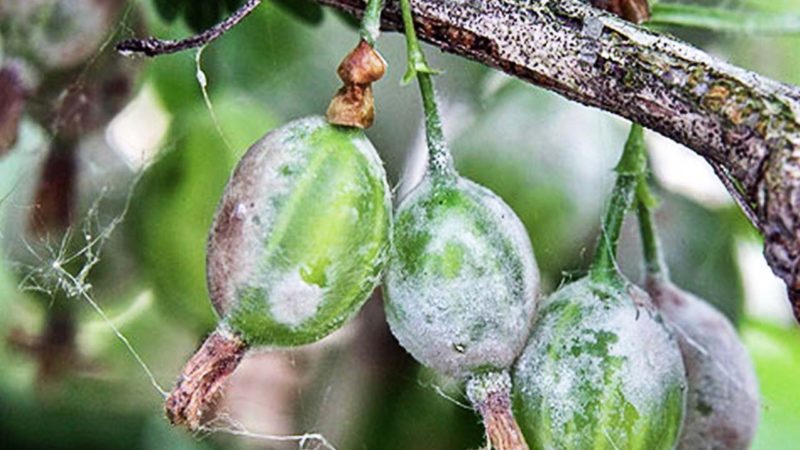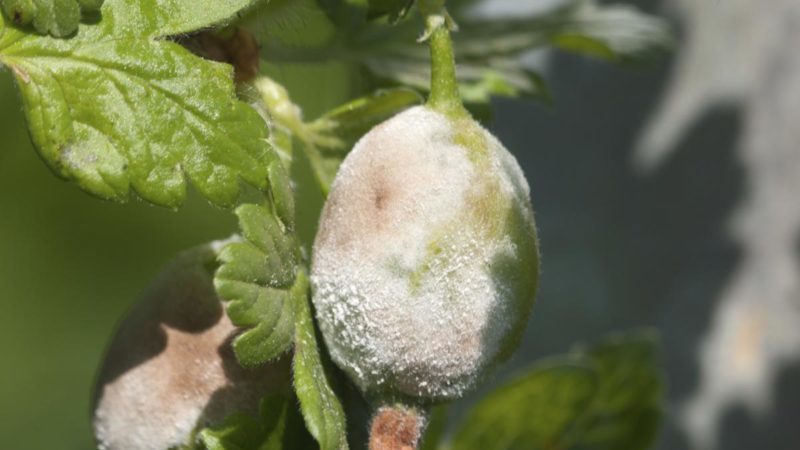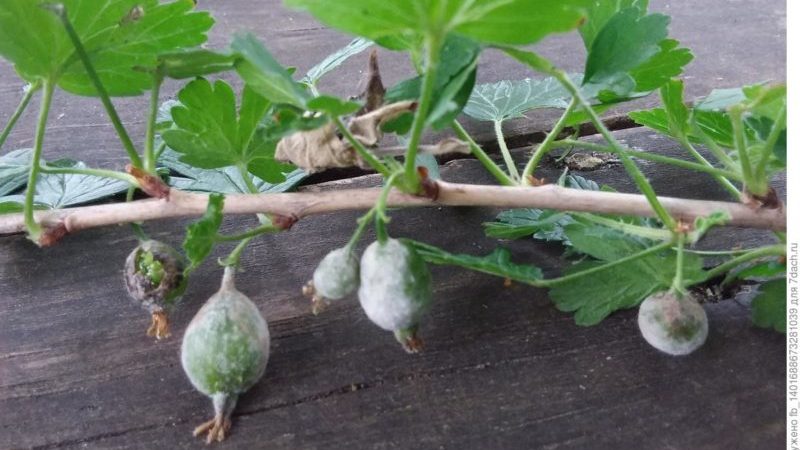How can you process gooseberries from white bloom on berries and what is the reason for its appearance
Gooseberry - winter-hardy, drought-resistant cultivated plant with high productivity. However, various diseases often affect him. In early summer, gardeners may notice that the fruits are covered with a white bloom. What to do in such cases and how to save the harvest? We will tell you how to correctly diagnose the disease and choose an effective treatment using chemicals and folk remedies.
The content of the article
Causes of the appearance of white bloom on berries and leaves
White bloom on a plant is one of the signs of gooseberry disease... This symptom is inherent in spheroteca (powdery mildew) and white spot at the final stage of development. In both cases, the causative agent of the disease is a fungus.
Spheroteka (powdery mildew) tightens gooseberry shoots and berries with a white felt bloom. The berries are severely affected at the beginning of ripening and stop developing. White bloom rarely appears on the leaves, its occurrence is more typical for the currant leaf blade.
Over time, the affected areas become yellow-brown in color, the leaves curl and dry out. Shoots bend, darken and die off.
Disease resistant varieties: Senator, Grushenka, Kolobok, Spring, Lada, Russian.
Septoria (white spot) is characterized by the appearance of spots on the leaves. They are usually lighter in color with a darker border, but can be yellow or gray-brown. With the development of the disease, the spots grow and occupy almost the entire surface of the leaf, and in their middle you can see mycelium with black dots. In the absence of timely treatment, gooseberry septoria is manifested by the following symptoms:
- drying of leaves and their premature shedding;
- drying of the tops of the shoots;
- wrinkling, bending of the stems.

The varieties Kooperator, Grushenka, Malakhit, Shannon, Beryl are relatively resistant to septoria.
Both diseases develop due to high air humidity (60-80%) at a temperature of + 20 ... + 30 ° C and non-compliance with agrotechnical requirements. In such weather conditions, it is not recommended to feed the gooseberry with nitrogen, since the increased growth of the plant will lead to the violent activity of the pathogen.
For reference... TO disease more prone to older, tall varieties of gooseberries, often pruned.
How to get rid of and how to process gooseberries from white bloom on berries
Regardless from the type of disease first of all, all damaged shoots and berries are removed and burned... To overcome the mycelium, they use complex measures, including preventive ones.
In the fall, to prevent the spread of the fungus, the shoots are trimmed to healthy tissue. The earth under the plantings is regularly dug up, the fallen leaves are destroyed, the soil is loosened.
The fight against spheroteka and septoria is carried out with fungicides. At an early stage of detection of the disease, folk remedies are tried.
Safety measures during processing
During processing, protective equipment is used. The working solution is prepared in a ventilated place, ideally outside. When working with fungicides, smoking, drinking water and food is prohibited. After finishing the treatment, shower and change clothes.
Important! If the solution enters the respiratory tract or mouth, consult a doctor immediately.
Fungicides for the treatment of vegetative plants are used before a possible infection or immediately after it.
Subject to the recommended doses and proper timing, the preparations are not phytotoxic. The duration of fungicide retention on the surface or inside the plants depends on the characteristics of the preparations and the meteorological conditions after irrigation.
The recommended time for the last treatment of shrubs is 20 days before harvest. After the specified time, the berries can be eaten.
Chemicals and drugs

Chemical treatment is carried out in dry, calm weather, in the early morning or late evening, when there is no activity of the sun's rays. Be sure to use protective clothing, respirator, gloves. The dosage is strictly observed.
From septoria
At the first signs of infection, all damaged areas are eliminated. Among a large number of drugs, the following have proven themselves in practice.
Bordeaux liquid
It is a mixture of copper sulphate and hydrated lime... For irrigation use 1% and 3% solution. The latter is acceptable for spring processing, until the bud breaks. 1% solution is used in the summer. The product is prohibited for use during the flowering period.
To prepare a 1% solution, 50 g of copper sulfate is diluted in 1 liter of warm water. In another container, mix 1 liter of water and 150 g of lime. Do not use metal containers. Liquid with vitriol is poured into a container with lime in a thin stream, stirring constantly. Add another 3 liters of water, mix and proceed to irrigation.
The process of preparing a 3% solution is identical, only the number of components increases: copper sulfate - 150 g per 1.5 liters of water, lime - 350 g per 2.5 liters. At the end, add another 1 liter of water so that the finished solution volume at the outlet is 5 liters.
In the period from spring to autumn, the total number of treatments for fruit and berry plants should not exceed 3 times.
For reference. To avoid plant burns, the solution is checked for acidity with litmus paper or an iron nail. If there is too much copper, the paper will turn red and a reddish coating will appear on the nail. Slaked lime is added to reduce acidity.
To avoid infection, in the spring, before budding, the shrubs are treated with 1% "Nitrofen" or copper sulfate.
"Captan"
Analogue of Bordeaux liquid. It is a water-wetting powder that suppresses the basic vital functions of fungi. Compatible with other fungicides, not phytotoxic.
The therapeutic effect is achieved within 36 hours from the moment of infection of the pathogen. Use the drug strictly according to the instructions. To obtain a 0.3-0.5% suspension, the consumption rate is 30-50 g per 10 liters of water.
"Phthalan"
Low toxicity to humans. Can be used with most fungicides except alkaline. For irrigation of fruit and berry crops, a 0.3-0.5% emulsion is used.
For processing gooseberries they are bred similarly to "Captan".
"Homezin"
A drug with a reduced level of toxicity. Recommended for processing during the growing season. The working solution is prepared at the rate of 1 package (40 g) of the product per 10 liters of water.
From spheroteka (powdery mildew)
Choosing the right product will help preserve the harvest. The most effective representatives of this group are presented below.
Fundazol
The versatility of the drug allows it to be used for processing adult plants and seed treatment before landing. Requires caution in use, since the product is highly toxic. However, due to the fact that the drug is not absorbed by leaves and shoots, it does not have a phytotoxic effect.
Not compatible with alkaline solutions. In the first three days after treatment, it suppresses the development of fungi and destroys cells. In the next 7 days it works as a protective agent.
Consumption rate: 10 g per 10 liters of water. Frequency of use - no more than 1 time in 10-12 days. The manufacturer promises an instant effect - 2 hours after irrigation.

"Topaz"
Able to suppress mycelium growth 3 hours after initial use.It is recommended to alternate with other fungicides due to the emergence of resistance of the fungal infection to the drug.
Waterproof, has a prolonged effect, which reduces the load on plants and reduces the number of chemical treatments. Use at any stage of the growing season is allowed. Consumption rate: 1 ml for 5 liters of water. It is permissible to double the volume when processing large shrubs. Can be used in all weather conditions.
"HOM"
One of the most effective fungicides, an analogue of Bordeaux liquid. It is easily washed off by rain, so it is best to use it during the period of least chance of precipitation. Treatment during flowering is carried out in exceptional cases, only in the evening.
During the growing season, it is not recommended to use the product more than 4 times. The working solution is prepared according to the scheme: 40 g per 10 l of water.
Previkur Energy
A complex product that combines the action of a fungicide and a pesticide. It almost completely suppresses pathogens in a short time (up to 3 days). Not phytotoxic. It activates the growth processes of the plant and strengthens its resistance mechanism to infection. Consumption rate: 1.5 ml per 1 liter of water.
Fight with folk remedies

Folk remedies in the fight against powdery mildew and white spot are used among complex measures, as an independent method they are ineffective.
As an auxiliary treatment, gardeners use:
- Fresh mullein. 1 part of the mullein is bred in 3 parts of water and allowed to brew for 3-4 days, after which it is filtered and again diluted in a 1: 3 ratio. Apply the solution with a broom, not with a sprayer, so as not to clog the sprayer.
- Soda ash. 50 g of sodium carbonate is dissolved in a small amount of water, 10 ml of liquid soap is introduced and the volume of the solution is brought to 10 l. They are processed on the eve of flowering and after it.
- Sour milk based solution. Whey and kefir are also suitable. The dairy product is diluted with water in a ratio of 1 liter to 9 liters of water. The procedure is carried out 3 times, every 3 days.
- Wood ash. 3 kg of ash is poured into a bucket of hot water. Let it brew for 24 hours, filter. Bushes are processed before and after flowering. Repeat the procedure until the symptoms disappear completely. The frequency of processing is once every 7 days.
- "Dangerous mix"... 1 aspirin tablet, 1 tsp liquid soap, 1 tbsp. l. soda and 1 tbsp. l. vegetable oil is mixed and diluted with 4-5 liters of water. Processed throughout the growing season with a frequency of 1 time in 14 days.
In order to prevent infection of bushes with diseases and pests in early spring, when the snow has not melted yet, plantings are treated with boiling water using a sprayer.
Conclusion
Spheroteca and septoria are diseases of gooseberries with a white bloom on the berries. Treatment is complex and often lengthy. These progressive diseases can destroy the entire crop of even the most prolific gooseberry varieties and require timely detection. Caring for plantings, preventing disease and using chemicals for treatment will allow for a bountiful harvest every year.